Kumbhabhishekam and Temple Architectures of Karya Siddhi Hanuman Temple in Frisco, TX USA
Prakasarao V Velagapudi, PhD Chairman, Datta Yoga Center, USA
(NOTE: This is a slightly revised version of the article published in the Souvenir during the Kumbhabhishekam time)
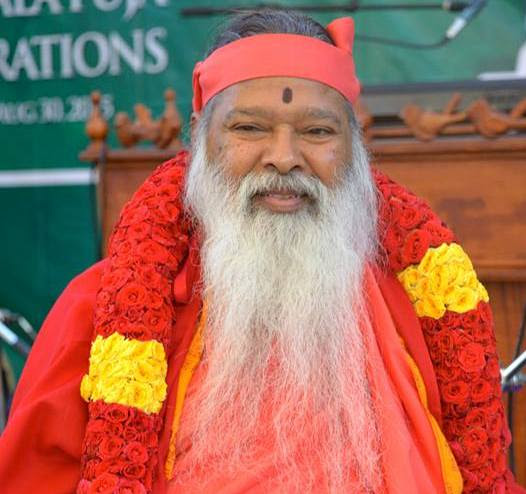 With blessings of Sri Ganapathy Sachchidananda Swamiji, Karya Siddhi Hanuman Temple is very happy to announce that the Maha Kumbhabhishekam will be celebrated from July 18 thru 23. Very elaborate plans to conduct Kumbhabhishekam are developed as per Agamic traditions assembling highly qualified priests. Thousands of devotees of Sri Swamiji from different countries are eagerly planning to converge onto Frisco, Texas, USA, with bubbling excitement, greater anticipation and unflinching devotion. Elaborate arrangements are being made by the Temple authorities with pride and honor to make sure the process will be as spiritual as uplifting.
With blessings of Sri Ganapathy Sachchidananda Swamiji, Karya Siddhi Hanuman Temple is very happy to announce that the Maha Kumbhabhishekam will be celebrated from July 18 thru 23. Very elaborate plans to conduct Kumbhabhishekam are developed as per Agamic traditions assembling highly qualified priests. Thousands of devotees of Sri Swamiji from different countries are eagerly planning to converge onto Frisco, Texas, USA, with bubbling excitement, greater anticipation and unflinching devotion. Elaborate arrangements are being made by the Temple authorities with pride and honor to make sure the process will be as spiritual as uplifting.Sri Ganapathy Sachchidananda Swamiji will perform Kumbhabhishekam which is a ritualistic process whereby divine energy generated by chanting of sacred Vedic mantras at the Homas is stored in Kalasha. Through Abhishekam the divine energy is ceremonially transferred to all the presiding Moorthys in the Temple as well as the Kumbhas that are placed on the outside Gopuras. This Kumbhabhishekam is believed to harmonize and unite the divine energy with the installed deities made of different stones. The stone vigrahas are transferred into centers of energy and power. Kumbhabhishekam is performed to benefit those who attend the function, visit the temple on a regular basis, and participate in the worship services. It is also believed even those who are unable to visit the temple but by just beholding the Gopuras/ Shikhars reap spiritual energy of the presiding deities.
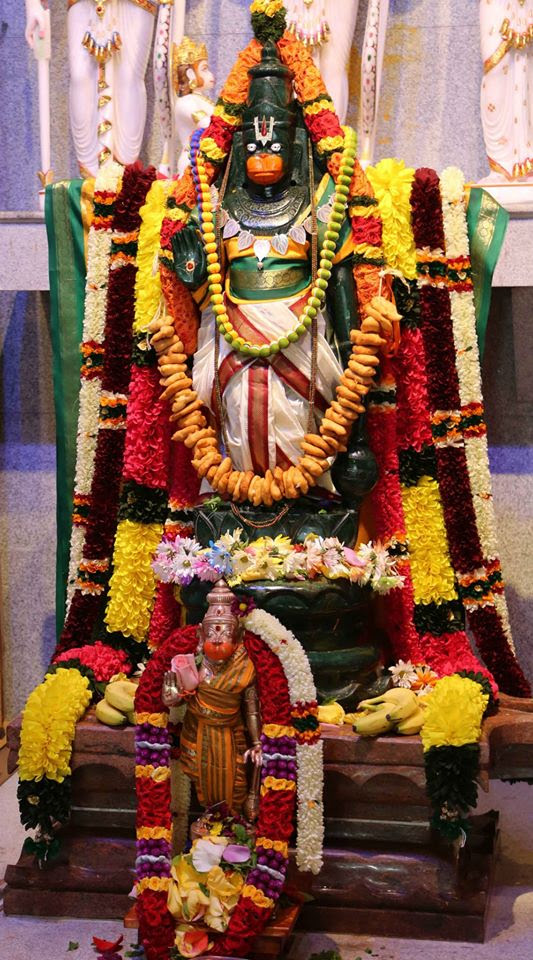 It is a great pleasure and an immense joy to be part of this massive construction of Hanuman Temple from its conception to the completion. It is even more satisfying to see thousands and thousands of people who had taken the opportunity to attend various temple activities, festivals and pujas. It is also gratifying to see so many thousandsof people who have availed the opportunity to see the progress of the temple on a daily basis and also contribute to the construction of the Temple. This kind of participation will be a role model for the next generation, follow the richness of our culture and breadth of extensive accumulated knowledge accumulated over so many centuries.
It is a great pleasure and an immense joy to be part of this massive construction of Hanuman Temple from its conception to the completion. It is even more satisfying to see thousands and thousands of people who had taken the opportunity to attend various temple activities, festivals and pujas. It is also gratifying to see so many thousandsof people who have availed the opportunity to see the progress of the temple on a daily basis and also contribute to the construction of the Temple. This kind of participation will be a role model for the next generation, follow the richness of our culture and breadth of extensive accumulated knowledge accumulated over so many centuries.
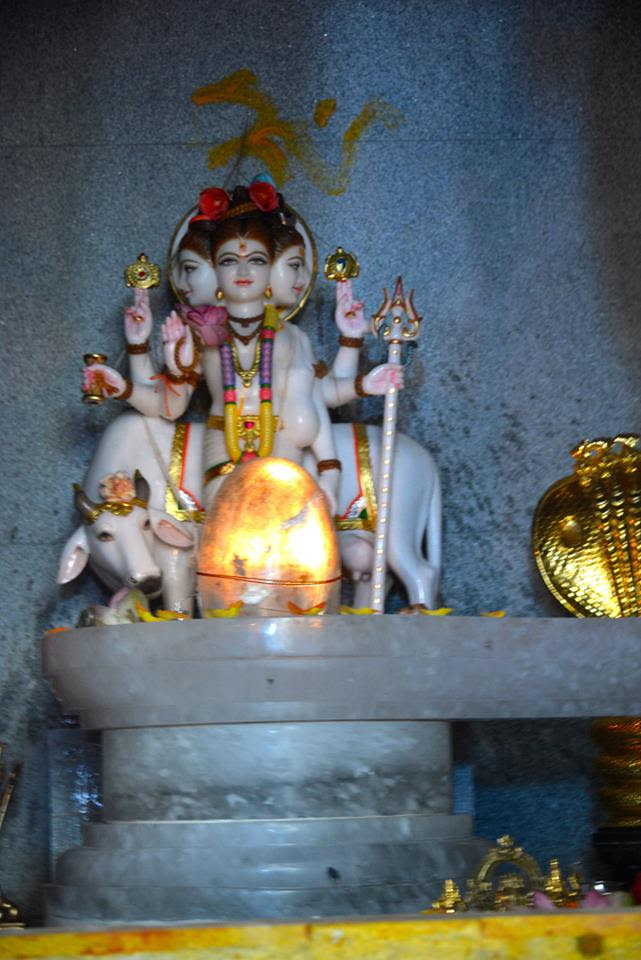 Karya Siddhi Hanuman Temple is unique in several respects. First it is conceived, planned, designed and selected by the Sthapathi to execute the Temple project following the specifications set by Sri Ganapathy Sachchidananda Swamiji. It is through His boundless compassion, that He guided the selection of the site, performed the Bhumi puja, selected the Vigrahas, and supervised the construction and planned the Kumbhabhishekam for July 23rd, 2015. In order to serve the ever expanding needs of the Hindu community across the United States, in July 2013, Sri Swamiji performed Bhumi Puja for a 34,000 square feet Temple. Hanuman Temple houses Lord Ganesh, Sri Durga Mata, Lord Hanuman, Ram Parivar, Shiva Linga, Lord Dattatreya, Lord Bala Subrahmanyam and Navagrahas. Hanuman Temple is one of the largest in USA with nearly 14, 000 square feet prayer hall that can accommodate 4000 devotees in the Mukhamandapam. Another 3,000 square feet Yagashala inside the Temple that can accommodate another 600 devotees. The most unique feature of the Temple is the selection of about 5 feet tall Marakata Hanuman Vigraha.The height inside the prayer is about 28 feet. Very imposing with lots of energy and power. Many people feel that it is like an Agraharam where more than hundred devotees of Sri Swamiji live on three sides of the Temple which is located in a ten acre lot. More than 30 shilpis came from India and worked very hard carving every inch of the Temple to make it a masterpiece. The painting of the Temples inside and outside are breath taking, amazing and astonishing. Nowhere in the Western hemisphere will one find a Presiding Deity made of Marakata. Shiva Linga made of Crystal is housed in the Temple. Another special feature of the temple is undoubtedly the Gopuram for Rajarajeswari that is fashioned to resemble Sri Chakra to appear as a pyramid, also known as Meru. Our Sadguru Sri Ganapathy Sachchidananda Swamiji decided to participate in Mandala Puja - meaning he is staying here in Frisco Texas for forty days from the day of Kumbhabhishekam, which is extraordinary for Sri Swamiji to stay in one place considering that is an Avadhuta. Sri Swamiji is spending enormous amount of time to create lots of energy to bless the community before he leaves in the first week of September. This temple is one of its kind.
Karya Siddhi Hanuman Temple is unique in several respects. First it is conceived, planned, designed and selected by the Sthapathi to execute the Temple project following the specifications set by Sri Ganapathy Sachchidananda Swamiji. It is through His boundless compassion, that He guided the selection of the site, performed the Bhumi puja, selected the Vigrahas, and supervised the construction and planned the Kumbhabhishekam for July 23rd, 2015. In order to serve the ever expanding needs of the Hindu community across the United States, in July 2013, Sri Swamiji performed Bhumi Puja for a 34,000 square feet Temple. Hanuman Temple houses Lord Ganesh, Sri Durga Mata, Lord Hanuman, Ram Parivar, Shiva Linga, Lord Dattatreya, Lord Bala Subrahmanyam and Navagrahas. Hanuman Temple is one of the largest in USA with nearly 14, 000 square feet prayer hall that can accommodate 4000 devotees in the Mukhamandapam. Another 3,000 square feet Yagashala inside the Temple that can accommodate another 600 devotees. The most unique feature of the Temple is the selection of about 5 feet tall Marakata Hanuman Vigraha.The height inside the prayer is about 28 feet. Very imposing with lots of energy and power. Many people feel that it is like an Agraharam where more than hundred devotees of Sri Swamiji live on three sides of the Temple which is located in a ten acre lot. More than 30 shilpis came from India and worked very hard carving every inch of the Temple to make it a masterpiece. The painting of the Temples inside and outside are breath taking, amazing and astonishing. Nowhere in the Western hemisphere will one find a Presiding Deity made of Marakata. Shiva Linga made of Crystal is housed in the Temple. Another special feature of the temple is undoubtedly the Gopuram for Rajarajeswari that is fashioned to resemble Sri Chakra to appear as a pyramid, also known as Meru. Our Sadguru Sri Ganapathy Sachchidananda Swamiji decided to participate in Mandala Puja - meaning he is staying here in Frisco Texas for forty days from the day of Kumbhabhishekam, which is extraordinary for Sri Swamiji to stay in one place considering that is an Avadhuta. Sri Swamiji is spending enormous amount of time to create lots of energy to bless the community before he leaves in the first week of September. This temple is one of its kind.
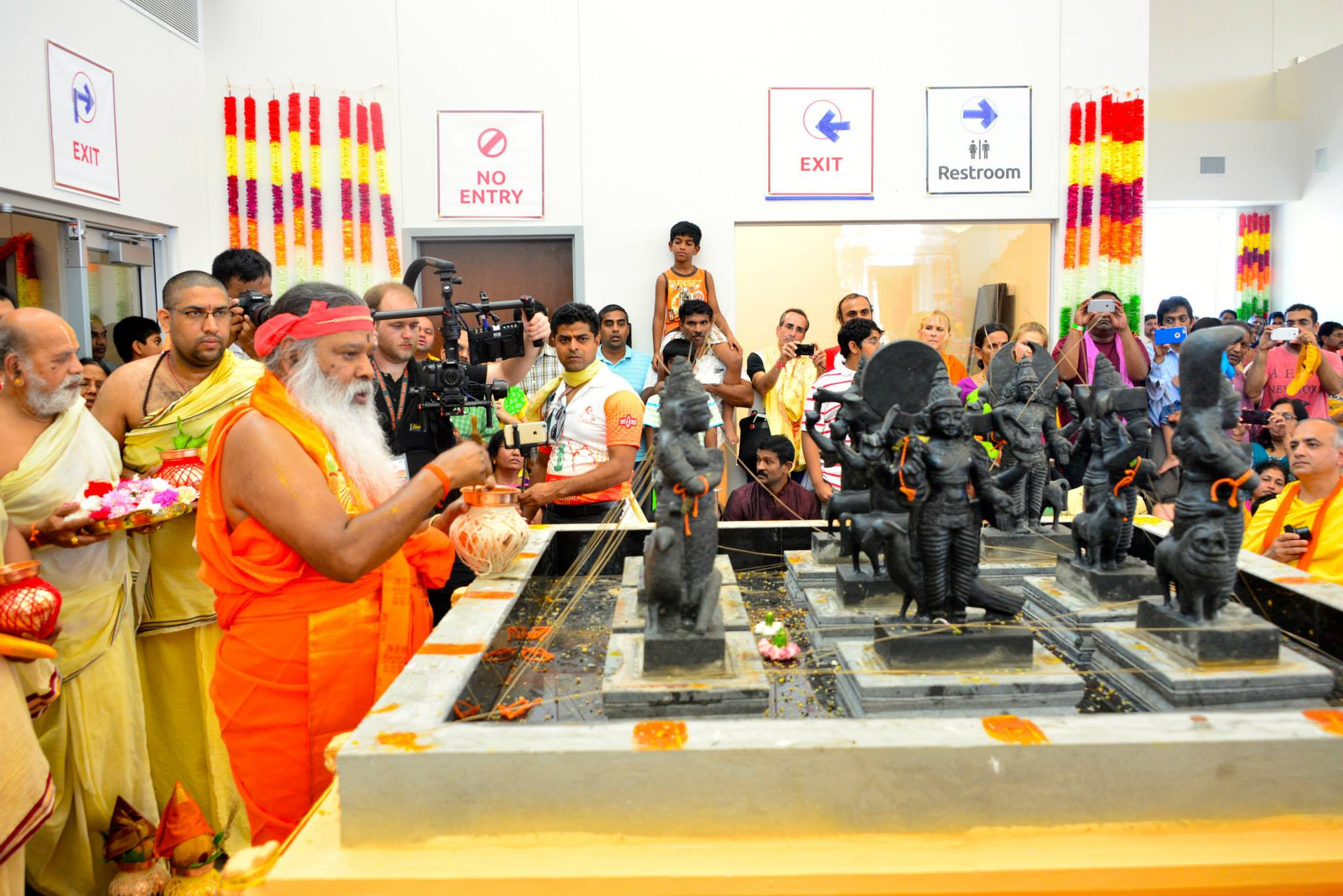 During Kumbhabhishekam, the rituals will be conducted byfollowing the ancient Vedic knowledge and Agama Shastras – sometimes referred to as Nigama and agama tradition respectively. The word Agama means the tradition which is coming from the times immemorial.Agama scriptures give detailed account of Murthy/Idol/ Image worship, Temple Construction and Vigraha Installation. The Agama texts clearly explain why we have to do the rituals. The concept behind installing the Deities is to enshrine the cosmic energy (Jagatvyapta Shakti) in the Idols. During the Installation ceremony the idol will be taken through the Agamic Sacraments such aalaya pravesam, sankalpam, punyahavachanam, rakshbandana, vastu Homas, ankurarpana and others. In order to purify the Moorthys, they are immersed in water and grains.
During Kumbhabhishekam, the rituals will be conducted byfollowing the ancient Vedic knowledge and Agama Shastras – sometimes referred to as Nigama and agama tradition respectively. The word Agama means the tradition which is coming from the times immemorial.Agama scriptures give detailed account of Murthy/Idol/ Image worship, Temple Construction and Vigraha Installation. The Agama texts clearly explain why we have to do the rituals. The concept behind installing the Deities is to enshrine the cosmic energy (Jagatvyapta Shakti) in the Idols. During the Installation ceremony the idol will be taken through the Agamic Sacraments such aalaya pravesam, sankalpam, punyahavachanam, rakshbandana, vastu Homas, ankurarpana and others. In order to purify the Moorthys, they are immersed in water and grains.
Kumbhabhishekam means transferring the power generated during the ritualistic performance of Homas that was captured into the Kalasas onto the Kumbha which is denoted as Shikhar or Head or Crown of the Gopuram. Prior to this, all theYantras are placed appropriately in each temple, and vigrahas are ritualistically installed in their appropriate temples following chanting of sacred mantras to purify the officiating priests, the place where Homas are conducted, nearby places and the cosmos. Then the Prana is infused into these presiding Murthys.Murthys remain material objects or figures until they are infused with life principle. Only then, the image is transformed into a living Deity to be worshipped and revered. Just before the “Praana Pratishta,” the following mantra is chanted to imply the transfer of prana: “Svaatma-samstham ajam suddham twaa-madhya Parameswara Aranyaa-miva havyaasam moortau aavaahayaam-yaham” “Oh Lord of the world, you are unborn and pure; Thou art in my heart; I invoke you in my concentration even as fire in wood comes out by friction.”
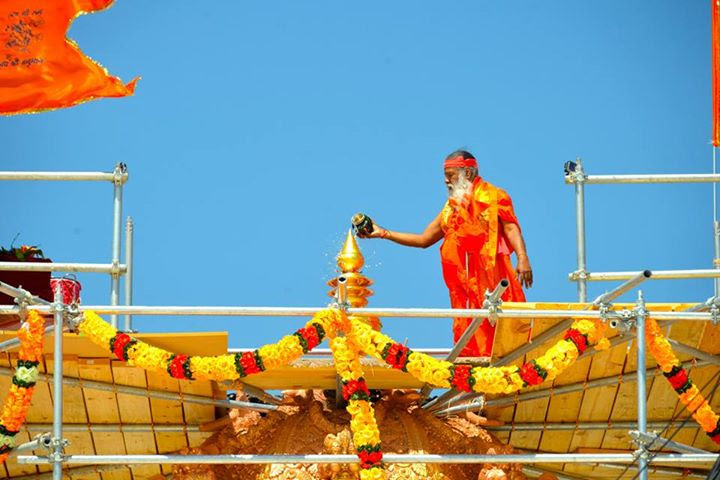 Only after necessary rituals are completed, the deities are qualified to worship and we can feel the presence of god in the Idols. Participants of these ceremonies will find each and every step of these rituals meaningful, interesting and exciting. Thousands of people assemble to witness this once in a lifetime event of Kumbhabhishekam and participate in all the rituals.
Only after necessary rituals are completed, the deities are qualified to worship and we can feel the presence of god in the Idols. Participants of these ceremonies will find each and every step of these rituals meaningful, interesting and exciting. Thousands of people assemble to witness this once in a lifetime event of Kumbhabhishekam and participate in all the rituals.
Every Devalayam, abode of God, popularly known as Hindu Temple, will follow prescribed rules and regulations in the planning and construction, using highly mathematical calculations as per AgamaShashtras and Shilpa Shashtras. A Hindu temple serves as the abode of a primary deity (known as the ‘Moola Murthy, or Pradhana Devata’) and provides a place for his or her devotees to make offerings and worship them. The deity is represented in a figurative sculptural form and is located within the ‘Garbhagriha’, literally meaning "womb chamber" and otherwise known as the Sanctum Sanctorum, or inner sanctuary.
How the Moorthys are sculptured?
 The word ‘Shilpa’ can be used in a general sense to mean ‘the art of sculpture’, but more particularly refers to the manifestation of an inner vision of the final work within the of the imagination of the Shilpi (sculptor) which guides his creation of the ‘Pratima’, the iconographic sculpture that provides a conduit for the physical manifestation of the deity. ‘Pratima’ literally means ‘measured form’, with its etymology deriving from ‘Prati’ (copy, replica) and ‘ma’ meaning ‘measure’. The process by which the Shilpi creates the physical object from the image within is defined by the Vastu Shastra Upanishad called “Shilpa Pratimaha Jayante”, which basically translates as, “from the inner-vision, the measured form is born”. The measures by which to create the pratima are known as the Pratima Lakshana, and are outlined by the Shilpi Rishis in the Shilpa Shastra.
The word ‘Shilpa’ can be used in a general sense to mean ‘the art of sculpture’, but more particularly refers to the manifestation of an inner vision of the final work within the of the imagination of the Shilpi (sculptor) which guides his creation of the ‘Pratima’, the iconographic sculpture that provides a conduit for the physical manifestation of the deity. ‘Pratima’ literally means ‘measured form’, with its etymology deriving from ‘Prati’ (copy, replica) and ‘ma’ meaning ‘measure’. The process by which the Shilpi creates the physical object from the image within is defined by the Vastu Shastra Upanishad called “Shilpa Pratimaha Jayante”, which basically translates as, “from the inner-vision, the measured form is born”. The measures by which to create the pratima are known as the Pratima Lakshana, and are outlined by the Shilpi Rishis in the Shilpa Shastra.
In Hinduism, a murti or murthy, or vigraha or pratima or bimbatypically refers to an image that expresses a Divine Spirit (murti). Meaning literally "embodiment", a murthy is a representation of a particular deity, made usually of stone, wood, or metal, which serves as a means through which a divinity may be worshiped. Hindus invoke the divinity in the murthy and consider the divine murtih to be worthy worship. The depiction of the divine image reflect the features, postures, gestures and expressions according to calculations and proportions outlined in Shilpa Shashtras.
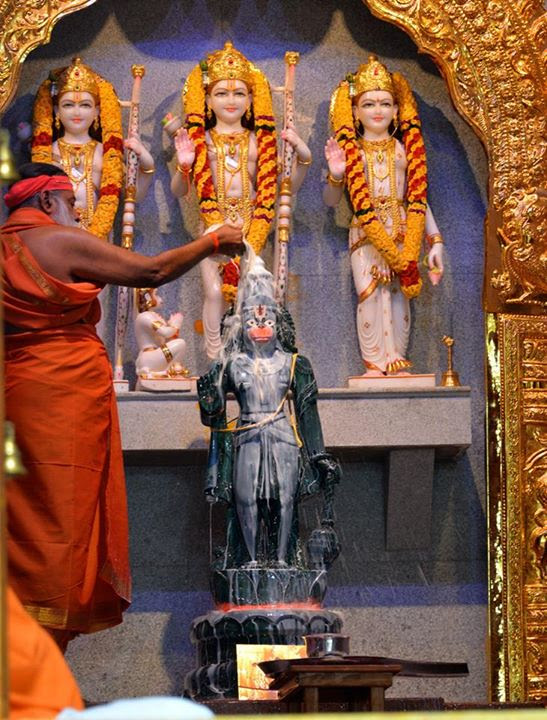 Prathima is also called Murthy and Vigraha. Diana Eck explains that the term Murthy in Sanskrit as “anything which has definite shape and limits; a form, body, figure; an embodiment, incarnation, or manifestation.” Thus, the Murthi is more than a likeness; it is the deity itself which has taken “form". The uses of the word Murthi in the Upanishads and the Bhagavad-Gita suggest that the form is its essence." Thus, a Murthi is considered to be more than mere likeness of a deity, but rather a manifestation of the deity itself. The Murthi is like a way to communicate with the abstract one God (Brahman) which creates, sustains, and dissolves creation.
Prathima is also called Murthy and Vigraha. Diana Eck explains that the term Murthy in Sanskrit as “anything which has definite shape and limits; a form, body, figure; an embodiment, incarnation, or manifestation.” Thus, the Murthi is more than a likeness; it is the deity itself which has taken “form". The uses of the word Murthi in the Upanishads and the Bhagavad-Gita suggest that the form is its essence." Thus, a Murthi is considered to be more than mere likeness of a deity, but rather a manifestation of the deity itself. The Murthi is like a way to communicate with the abstract one God (Brahman) which creates, sustains, and dissolves creation.
According to the Makutagam (Agama) scriptures, when the pratima is thus constructed with the correct proportions of measurement outlined within the sacred texts, the sculpture is imbued with the qualities of the divine and the deity will be truly expressed through the image. Not only is this process sacred, it is considered as a science. In an Upanishad entitled ‘Shilpa Vidya Rahasyopanishad’, it states “Vijnanam ShilpaKaushalyam, Jagat Sarvam Shukpameva Bhavati’ or that the “Shilpa’s greatness lies in it being scientific”. Every inch of the deity is measured to make sure that all the features, expressions and limbs are proportionately carved according to the calculations described in Shilpa Shastra.
How the Temples are Constructed and Consecrated?
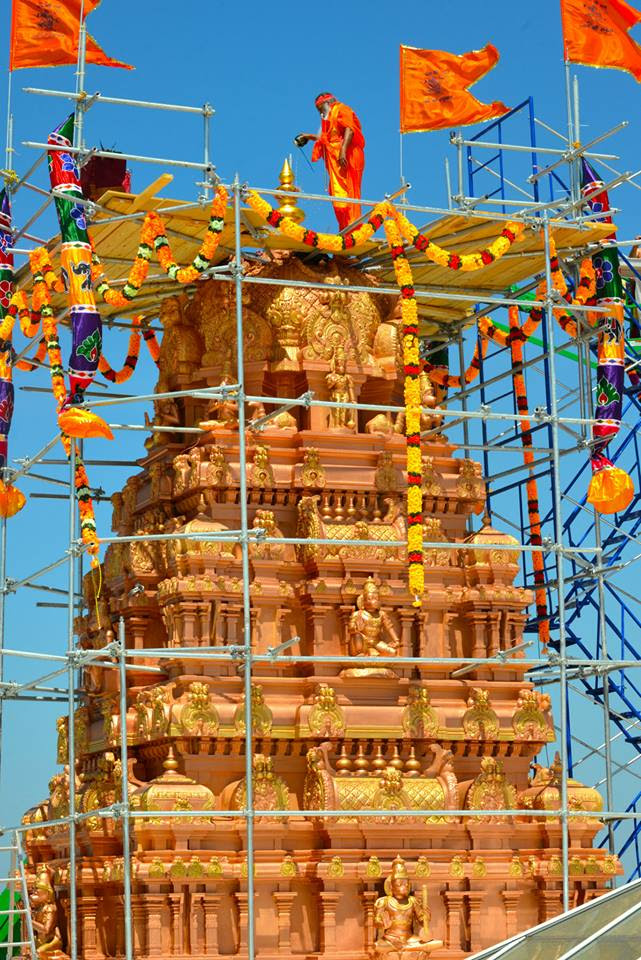 It is firmly believed that there is a close relationship between human being and the Cosmos. What is seen in macrocosm is also seen in microcosm. The laws governing the Cosmos also govern the human being.It is amply mentioned in Brihadaranyaka Upanishad (1.4.10) in a great saying known as 'Aham Brahmasmi' ("I am Brahman) to mean ‘Whatever is in the Universe, is present in me’ (and ‘whatever is in me, is present in the Universe’). Whenever our Sthapathis draw the plans to build Temples they will make sure that temples represent the macrocosm of the universe as well as the microcosm at the individual level. Veda also says, "Yatha Pinde Tatha Brahmande".
It is firmly believed that there is a close relationship between human being and the Cosmos. What is seen in macrocosm is also seen in microcosm. The laws governing the Cosmos also govern the human being.It is amply mentioned in Brihadaranyaka Upanishad (1.4.10) in a great saying known as 'Aham Brahmasmi' ("I am Brahman) to mean ‘Whatever is in the Universe, is present in me’ (and ‘whatever is in me, is present in the Universe’). Whenever our Sthapathis draw the plans to build Temples they will make sure that temples represent the macrocosm of the universe as well as the microcosm at the individual level. Veda also says, "Yatha Pinde Tatha Brahmande".
It means what is going on within human being is the same as what is going on in universe. According to the Tamil Saint Tirumular, "our body is a temple". Hindu Temples play a vital role in the preservation of culture and the worship of millions of Hindus around the globe. They are the place of worship where devotees worship their chosen Gods at different times, day in and day out. Devotees go to the Hindu Temples to experience the infinite divine power through their individual prayers as well as collective worship.
Hindu Temples have been built over more than twenty centuries providing opportunity to practice their social, religious and cultural milieu. Each Temple is dedicated to one ofthe manifestations of the infinite power, that unfathomable divinity of the Almighty. 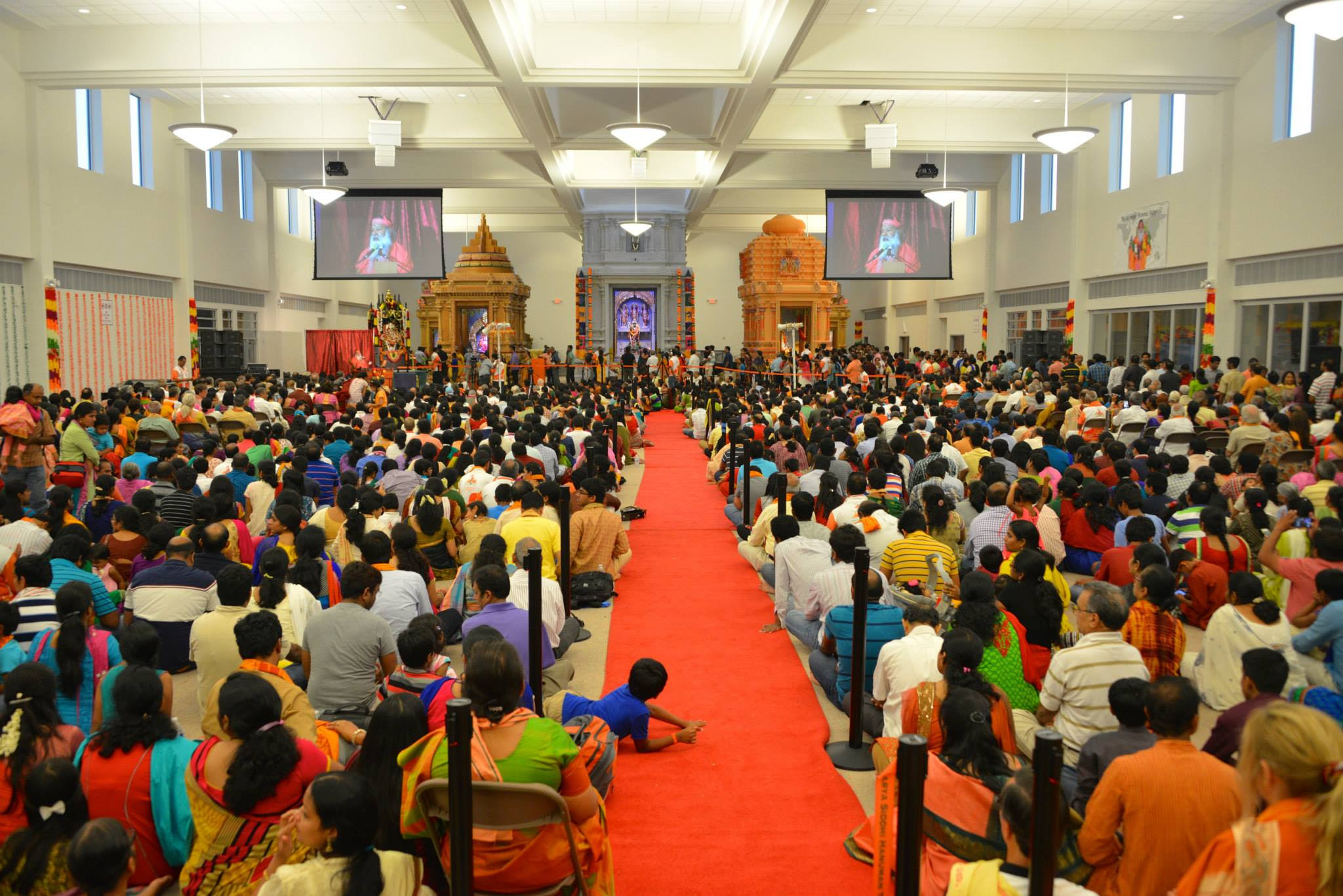 Every Temple will have a sanctum sanctorum with a presiding Deity who represents the power and energy of GOD. There is no tradition of building huge temples in any other religion compared to Hinduism to honor the mass of energy that resides in the image. Hindus believe that God is ever powerful; everywhere, everything and everything is in God. Hindu Temples are architectural wonders, masterpieces and marvels representing the diversity of culture of the countries. They are as magnificent as majestic, as beautiful as bewitching, as amazing as astonishing, as grandeur as graceful, as imaginative as intuitive, as potent as powerful, as complex as complicated, as intricate as innovative, as splendid as spectacular, as ingenious as inspirational, as mathematical as meticulous, as precise as proportional, as scientific as spiritual, and as creative as compelling. As Rabindranath Tagore, the great Indian Nobel Laureate for poetry, observed: “Here the language of stone surpasses the language of man." Karya Siddhi Hanuman Temple will serve as center of learning and knowledge for all age groups; foci for social gathering; facility for art, dance and music; hub for upholding the dharmic values; sacred place for conducting daily rituals such as Archanas, Homas, Pujas and other Samskaras; nucleus for peace, tolerance,and nonviolence; lighthouse for philosophy and spirituality, cornerstone for worship services; promotion of age old, time tested universal values; institute for yoga and meditation; holy place for conducting different festivals and rituals; and nexus for expressing devotion through music, singing and chanting; and center for addressing the community needs.
Every Temple will have a sanctum sanctorum with a presiding Deity who represents the power and energy of GOD. There is no tradition of building huge temples in any other religion compared to Hinduism to honor the mass of energy that resides in the image. Hindus believe that God is ever powerful; everywhere, everything and everything is in God. Hindu Temples are architectural wonders, masterpieces and marvels representing the diversity of culture of the countries. They are as magnificent as majestic, as beautiful as bewitching, as amazing as astonishing, as grandeur as graceful, as imaginative as intuitive, as potent as powerful, as complex as complicated, as intricate as innovative, as splendid as spectacular, as ingenious as inspirational, as mathematical as meticulous, as precise as proportional, as scientific as spiritual, and as creative as compelling. As Rabindranath Tagore, the great Indian Nobel Laureate for poetry, observed: “Here the language of stone surpasses the language of man." Karya Siddhi Hanuman Temple will serve as center of learning and knowledge for all age groups; foci for social gathering; facility for art, dance and music; hub for upholding the dharmic values; sacred place for conducting daily rituals such as Archanas, Homas, Pujas and other Samskaras; nucleus for peace, tolerance,and nonviolence; lighthouse for philosophy and spirituality, cornerstone for worship services; promotion of age old, time tested universal values; institute for yoga and meditation; holy place for conducting different festivals and rituals; and nexus for expressing devotion through music, singing and chanting; and center for addressing the community needs.
Human body resembles the Temple
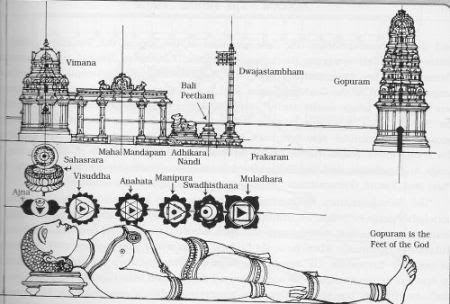
Sri Swamiji compared the human body to the Hindu Temple on numerous occasions and how the temple structure can be compared with the human body.He mentioned that since God resides within our body (temple), we must maintain bodily purity. That means the purity of the body depends on the kind of food we eat, the habits of personal hygiene, and mental processes.The most appropriate Shloka narrating the relationship between Temple and human body is found in “Viswakarmyam Vastu Shastra”:
"Garba Gruha Sirahapoktam Antaraalam Galamthatha
Ardha Mandapam Hridayasthanam Kuchisthanam Mandapomahan
Medhrasthaneshu Dwajasthambam Praakaram Janjuangeecha
Gopuram Paadayosketha Paadasya Angula Pokthaha
Gopuram Sthupasthatha Yevam Devaalayam angamuchyathe"
Meaning: Garbhagriha (sanctum sanctorum) is equated with human head; Antaralaya (vestibule) is equated with human neck; Ardha Mandapam (half-hall) is compared with human chest; Maha Mandapam (main hall) is equated with the stomach; flag-post is viewed along with human male organ;and Gopuram or temple gateway tower is viewed along with human feet.
Vedas and Agama Tradition
The Agama tradition is often contrasted with the Nigama tradition; the latter possibly a reference to the unchanging, eternal Vedic tradition. Hinduism of today is in many ways a blending of Agama and Nigama traditions.
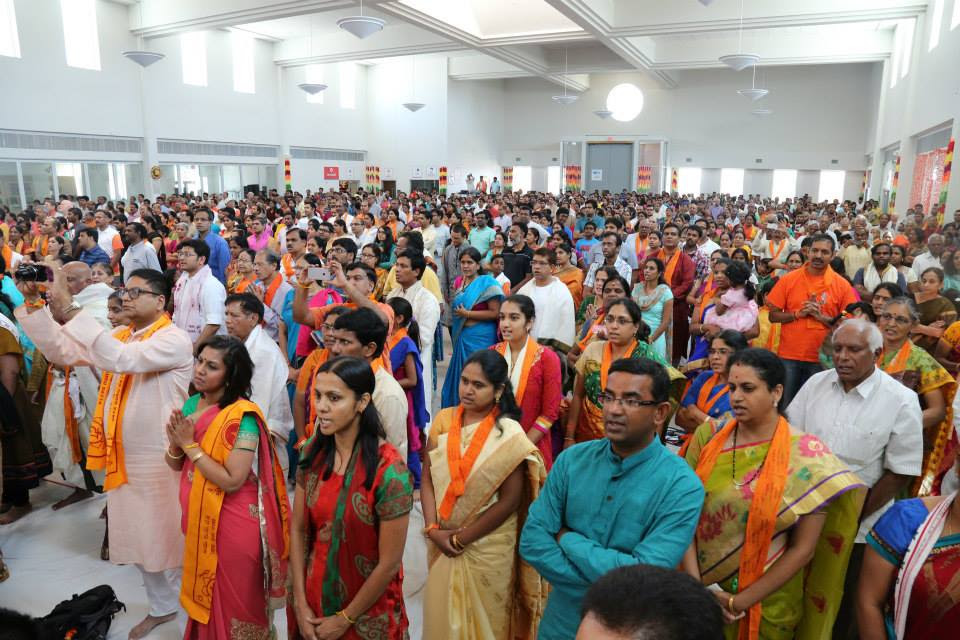 Although temple worship is not mentioned in the Vedas, the spirit, the essence, and hidden meaning of Vedas are reflected in conducting all the rituals in the Temple as well as the Pranaprathishta rituals. In Vedas, a number of Gods and Goddesses have been invoked, praised and sought for their benevolence. They includedeities such as Indra, Surya, Agni, Asvinis, Vayu, Varuna, Mitra, Aditi, Yama, Soma, Sarasvati, Prithvi, Vishnu,and Rudra. In fact, Vedic hymns refer to these and other deities, often 33, consisting of 8 Vasus, 11 Rudras, 12 Adityas, Prajapati Brahma and Sri Hari Vishnu.The energy created by conducting the Homas, rhythmic chanting of Vedic mantras, and invoking the blessings of different gods is eventually transferred to the presiding deities during the Pranaprathishta by Sri Ganapathy Sachchidananda Swamiji.
Although temple worship is not mentioned in the Vedas, the spirit, the essence, and hidden meaning of Vedas are reflected in conducting all the rituals in the Temple as well as the Pranaprathishta rituals. In Vedas, a number of Gods and Goddesses have been invoked, praised and sought for their benevolence. They includedeities such as Indra, Surya, Agni, Asvinis, Vayu, Varuna, Mitra, Aditi, Yama, Soma, Sarasvati, Prithvi, Vishnu,and Rudra. In fact, Vedic hymns refer to these and other deities, often 33, consisting of 8 Vasus, 11 Rudras, 12 Adityas, Prajapati Brahma and Sri Hari Vishnu.The energy created by conducting the Homas, rhythmic chanting of Vedic mantras, and invoking the blessings of different gods is eventually transferred to the presiding deities during the Pranaprathishta by Sri Ganapathy Sachchidananda Swamiji.
Kumbhabhishekam is not only a ritual, but a rare life time event to experience the omnipresence, omniscience and omnipotence of the Divinity in all the presiding deities in the Temple. We don’t get such a Divine opportunity again and again. Direct participation in the ceremony will definitely allow the devotees to experience the Divine Bliss and enable one to acquire the very essence of the characteristics of the presiding deities, either consciously or unconsciously. The sweetness of honey is known only when one tastes it. The bliss of attending the function is experienced only when we attend the function.Let us all remember the words in Kathopanishad, UttishhThata Jaagrata Praapya Varaannibodhata, meaning, “Arise, Awake and Stop not until the goal is reached.” The goal is to experience the divine nature of Lord Hanuman by participating in this powerful Kumbhabhishekam ceremony.












 Urgent support needed for Bangladesh Hindus
Urgent support needed for Bangladesh Hindus 







